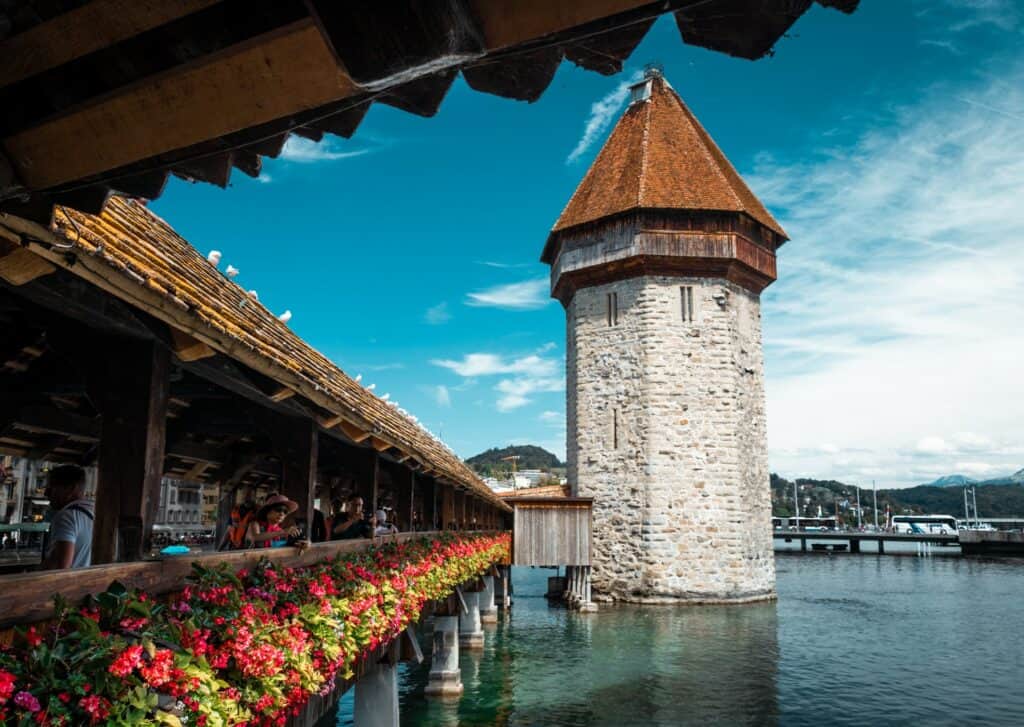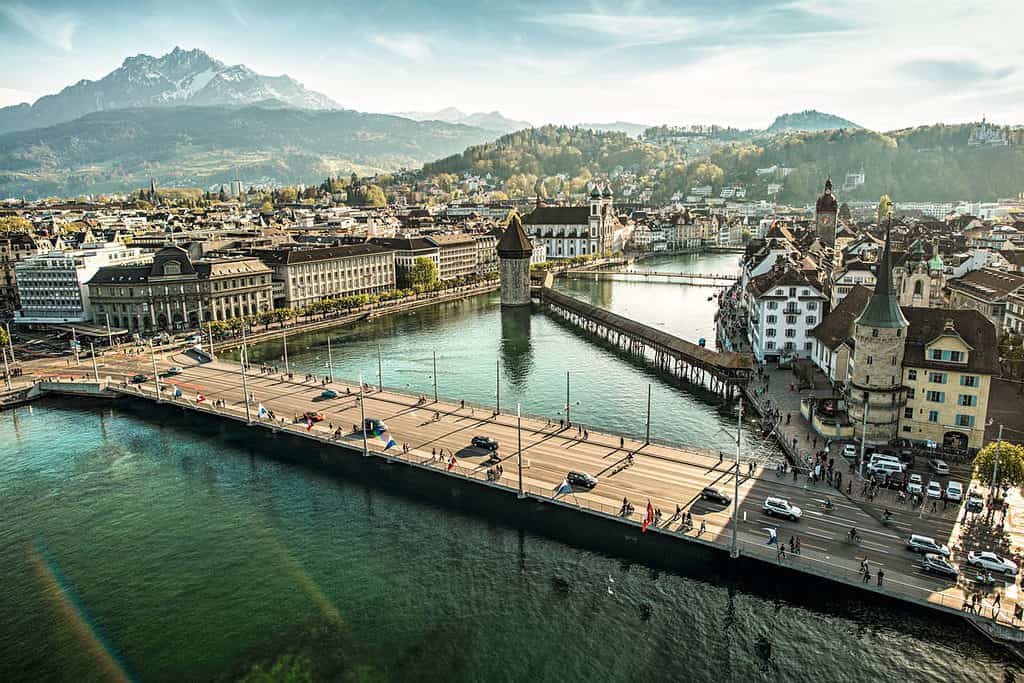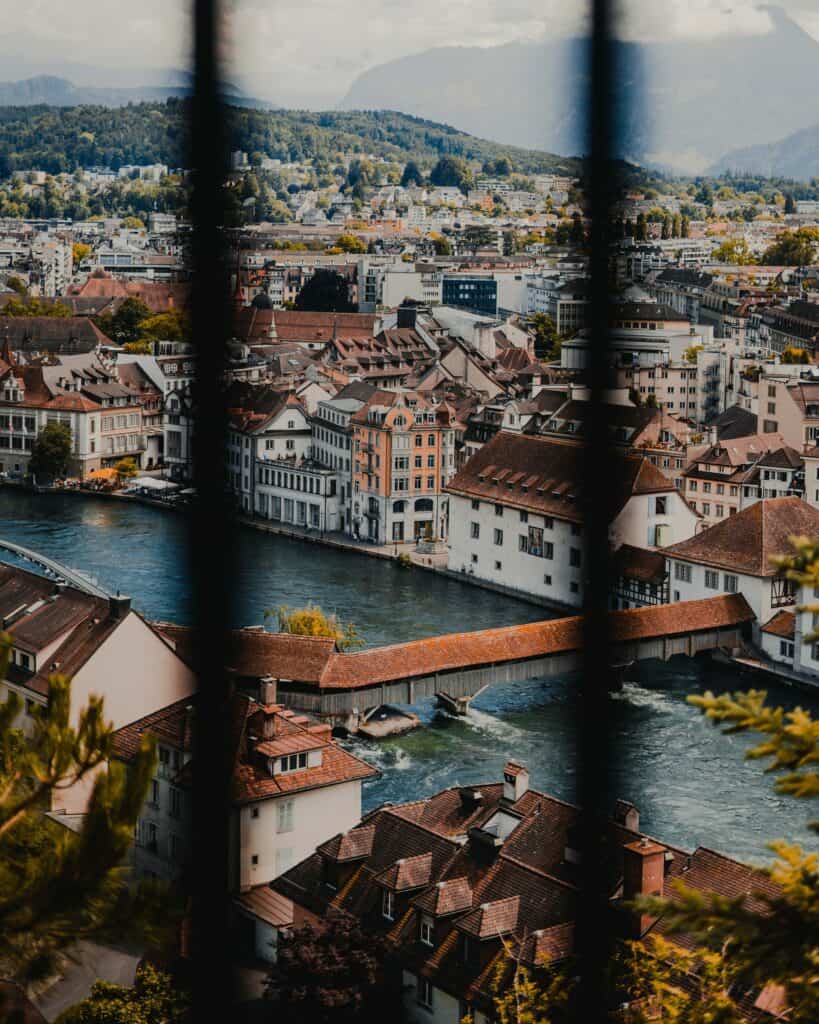The Chapel Bridge, also known as the Kapellbrücke, is a wooden footbridge that spans across the River Reuss in the city of Lucerne, Switzerland. It is an iconic and beloved landmark in the city, known for its unique architecture and its rich history.
In addition to its historical and cultural significance, the Chapel Bridge is also a popular spot for photography due to its picturesque location and stunning views of the city. It is considered one of the most photographed landmarks in Lucerne, and is a must-see destination for anyone visiting the city.
The Chapel Bridge Landmark of Lucerne
The Chapel Bridge is a popular tourist attraction, known for its unique architecture and rich history. The bridge is a wooden footbridge that spans across the River Reuss, connecting the New Town on the southern bank with the Rathausquai in the medieval Lucerne Old Town. As visitors cross the bridge, they are treated to a front-row seat to the history of the city, with stunning paintings and triptychs adorning the sides of the bridge.

The Chapel Bridge is considered to be one of the most iconic landmarks in the city, and it is hard to imagine Lucerne without it. It is a beloved destination for both tourists and locals alike, offering a picturesque setting. In addition to its historical and cultural significance, the bridge is also a popular spot for photography due to its stunning views of the city and the surrounding landscape.
Along with the Chapel Bridge, the Water Tower is another iconic landmark in Lucerne. The tower is an octagonal structure that stands at a height of over 34 meters (111.5 ft.). Together, the Chapel Bridge and the Water Tower form a landmark in the city that is recognized and beloved by visitors from all around the world.
The History of the Chapel Bridge
The Water Tower, also known as the Wasserturm, is an octagonal structure that stands at a height of over 34 meters (111.5 ft.), and is an important landmark in the city.
The Water Tower was originally built in the 13th century as part of the city’s fortifications, and served a number of different purposes throughout its history. It was used as an archive, treasury, prison, and even a torture chamber.
You might also like the following article:
The Chapel Bridge is considered to be Europe’s oldest covered bridge, with a construction date that is thought to be around 1360 and hence later than the Wassertum. The first mention of the bridge in historical records dates back to 1367.
The Chapel Bridge originally served as a link between the old town, located on the north bank of the river, and the new town on the south bank. It was originally 200 meters in length, but due to numerous shortenings and river bank replenishments, it is now only 170 meters long.
The Fire Disaster
On the night of August 17-18, 1993, a fire destroyed around two thirds of the 205-meter-long Chapel Bridge in Lucerne, Switzerland. The cause of the fire is unknown, but it spread rapidly through the roof beams, fueled in part by spiders’ webs in the gables. The fire brigade faced a difficult challenge due to the length of the bridge, but was able to contain the fire and save the two bridgeheads and supporting structure. Researchers spent several months documenting every element of the bridge in order to reconstruct it, and construction was completed in April 1994 at a cost of CHF 3.4 million. The sections of the bridge damaged by the fire are still marked today.

Painting Decoration of the Bridge
Chapel Bridge, located in the city of Lucerne, Switzerland, is a well-known landmark not only for its length but also for the artworks that adorn its roof. These paintings, which are housed in triangular frames, depict a variety of stories about the city’s rich history, including the lives of Lucerne’s patron saints St. Leodegar and St. Maurice. These artworks were created in the 17th century by a local artist named Hans Heinrich Wägmann, and were painted on spruce wood boards.

The paintings on Chapel Bridge are considered to be quite intricate and were funded by members of the city council, who sponsored a painting and were able to include their personal coat of arms in the piece. Beneath each painting, there is an explanation of the story it depicts. Prior to 1993, there were a total of 147 paintings on the bridge, but on August 18th of that year, a fire destroyed two thirds of them. Of the 47 paintings that were recovered after the fire, only 30 of them were fully restored. The remaining damaged paintings were replaced with ones that had been safely stored since 1834.
As visitors walk across Chapel Bridge, they are treated to an impressive sight with these intricate paintings on display. It is recommended to take a moment to appreciate the historical significance of these artworks. However, it is worth noting that the paintings are not on display during the festive Carnival days, which take place from late January to early February. During this time, the paintings are replaced with modern ones featuring carnival-themed themes.
Best Place to see/photograph Chapel Bridge
The best place to view Chapel Bridge is from the bridge itself, as many other bridges do not offer such a spectacular vantage point. Another place that offers a perfect view to see the Chapel Bridge is from the west bank of Lake Lucerne, just across from it. From that vantage point, you’ll be able to appreciate it in all its glory and you won’t have to fight for a good spot since there are plenty of benches along the lake’s edge.

The best times to see the bridge are in the morning or evening when it is lit up with lights and reflecting in Lake Lucerne. If you want to photograph the bridge, plan ahead and schedule your visit during one of these times to get great shots of its beauty.
For photography purposes, go during daylight hours so that you can get good lighting and color on the bridge itself. You can also shoot at night when there are fewer people around and the views are clearer. Keep in mind that after sunset and before sunrise are often low-light situations on the bridge, so consider using a camera and tripod that allows long exposure photos.
The other wooden Bridge in Lucerne
You may have noticed that there’s more than one wooden bridge in Lucerne. The Chapel Bridge is the most famous, but it’s not the only one. While many tourists flock to this pedestrian-only bridge to take photos of its striking red color, there’s another bridge in town that you should know about, the Chaff Bridge.
The Chaff Bridge is considered a symbol of the city and one of its landmarks. The Wooden Bridge is also a pedestrian that originally connected the mill place (Mühlenplatz) on the right-hand side of the Reuss river with the mills at the center of the river.

The Chaff Bridge was built as part of the city’s defenses in the 13th century and was completed in 1408. It got its name “Chaff” because it allowed the local flour mills to discharge trash into the Reuss River.
The Court Bridge (German: Hofbrücke) was a wooden bridge located in Lucerne that was dismantled in the 19th century. It was the third wooden bridge in the city, after the Chapel Bridge and the Chaff Bridge. The Court Bridge was located near the city’s medieval court and was used by judges and other officials to access the court. It is now only known through history books and is no longer in existence.
You might also like the following article:
Summary & Final Thoughts
The Lucerne Chapel Bridge is a landmark to behold. It is one of the most beautiful bridges in the world and a must-see for any visitor to Lucerne. There are many ways to get there, but we recommend taking a boat trip across Lake Lucerne to enjoy the view from both sides of the river.
The Chapel Bridge is the perfect place to soak in the serenity of a Lucerne afternoon. An incredibly picturesque spot, this small bridge has the best view when the sun is shining and the lake is calm.
